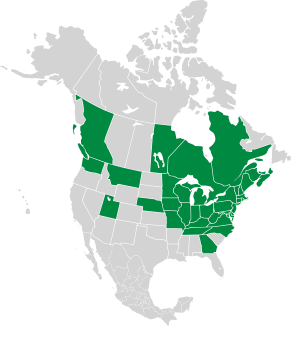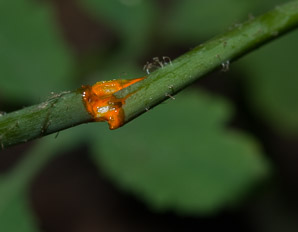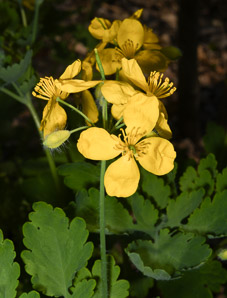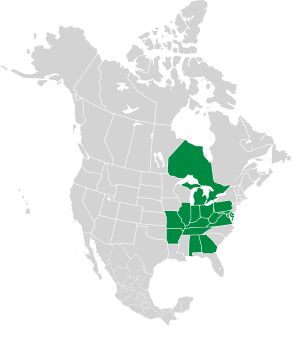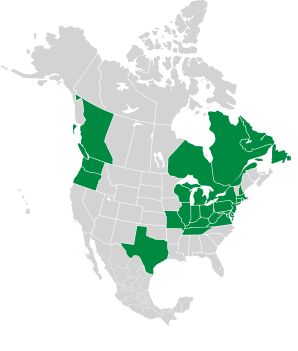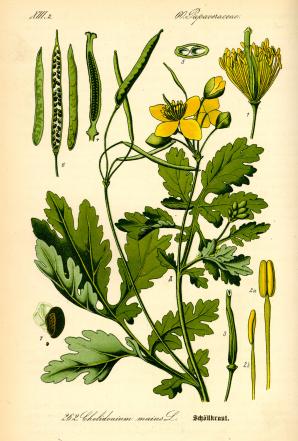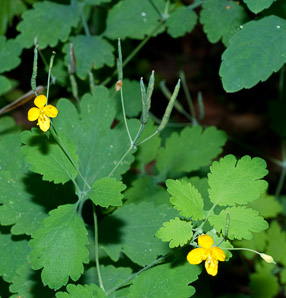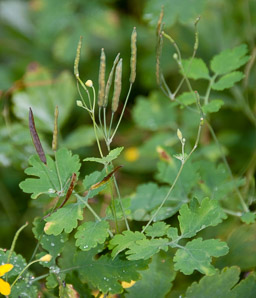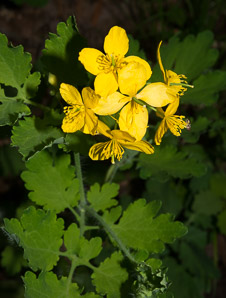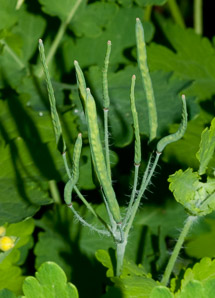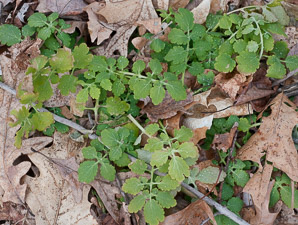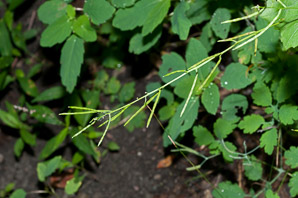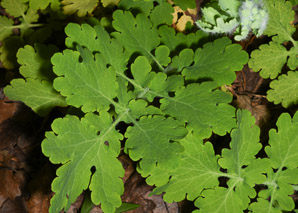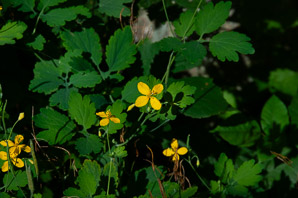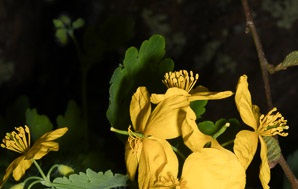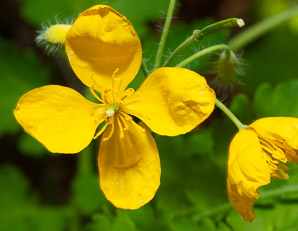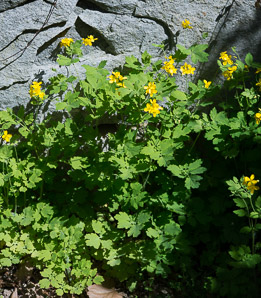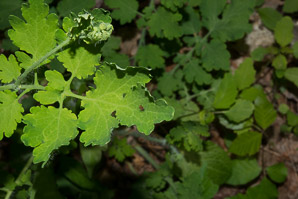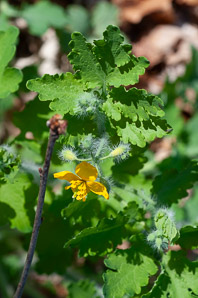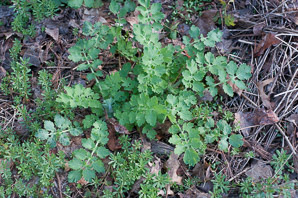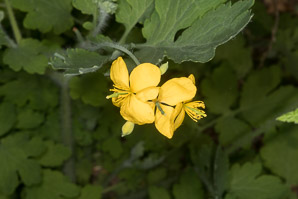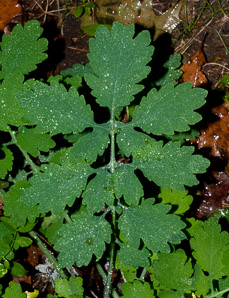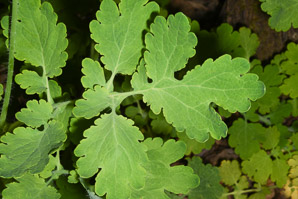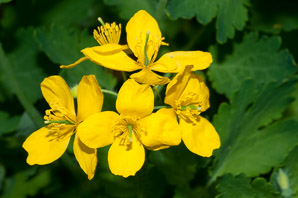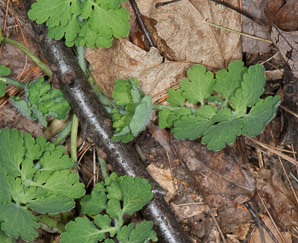
|
Chelidonium majus L. Greater celandine, celandine
This native of Eurasia was introduced to North America, where it is now widespread. Plants: Greater celandine reaches 1½-2′ (45-60 cm) in height, with ribbed stems. Leaves contain an irritating yellow-orange sap. Leaves: Leaves are up to 8″ (20 cm) long and 3″ (7.6 cm) wide, compound in groups of 5 to 9, green with a slight bluish tint. Flowers: About ¾″ (1.9 cm) around, with four yellow non-overlapping petals, a stiff green central style, and multiple yellow stamens. Fruits: Seed capsules look like thin beans, ¾-2½″ (1.9-6.3 cm) long, with black seeds. Sometimes these are confused: |
The sap is bright orange. · 7/17/2013 · Near Nashua River Boat Ramp, Groton, Massachusetts · ≈ 6 × 3½″ (14 × 9.6 cm) |
||||||||||||||||||||||||||||
|
| |||||||||||||||||||||||||||||
Stylophorum diphyllum |
Ranunculus ficaria |
You are here Chelidonium majus |
|||||||||||||||||||||||||||
|---|---|---|---|---|---|---|---|---|---|---|---|---|---|---|---|---|---|---|---|---|---|---|---|---|---|---|---|---|---|
| Common Name |  |
 |
 |
||||||||||||||||||||||||||
| Plant | Plants reach 1-1½′ (30-45 cm). Stems and leaves exude a bright yellow-orange sap when cut. | Low-growing, 4-14″ (10-35 cm) in height. It is a perennial that stores energy in numerous white finger-like tubers. | Greater celandine reaches 1½-2′ (45-60 cm) in height, with ribbed stems. Leaves contain an irritating yellow-orange sap. | ||||||||||||||||||||||||||
| Flowers | Each flower has four partially overlapping yellow petals, two sepals (which fall away early after flowering), a knobby stigma, and multiple yellow-orange stamens. They appear in groups of one to four, and are 1¼-2″ (3.2-5.7 cm) around. Flowers May-June. | Up to 1″ (2.5 cm) around, with 7-12 glossy yellow petal-like tepals, and 3 sepal-like tepals (confused yet?). They appear as early as February, or, further north, from April-May. | About ¾″ (1.9 cm) around, with four yellow non-overlapping petals, a stiff green central style, and multiple yellow stamens. | ||||||||||||||||||||||||||
| Leaves | This plant has basal leaves, as well as a pair of opposite leaves on the stem, both up to 6″ (15 cm) × 4″ (10 cm). Leaves are divided into 3-5 lobes which in turn are further divided, making them bipinnatifid. Leaf surfaces are dark green and hairless, while leaf undersides are pale as a result of fine hairs. Leaf stems (petioles) are up to 4″ (10 cm) long. | Thick, heart-shaped (cordate), spirally arranged, ¾-1½″ (1.9-3.8 cm), on long stems (petioles). Leaves are sometimes mottled with darker green patches. | Up to 8″ (20 cm) long and 3″ (7.6 cm) wide, compound in groups of 5 to 9, green with a slight bluish tint. | ||||||||||||||||||||||||||
| Fruit | Bristly blue-green ovoid seed pods ¾-1″ (1.9-2.5 cm). | Achenes are spherical, up to ⅜″ (1.3 cm) around. | Seed capsules look like thin beans, ¾-2½″ (1.9-6.3 cm) long, with black seeds. | ||||||||||||||||||||||||||
| Range/ Zones |
|
|
|
||||||||||||||||||||||||||
| Habitats | Dry deciduous woodlands, bases of bluffs, and rocky stream banks. | It prefers damp shady areas, and weedy places. It often carpets large areas. | Moist or dry woods, thickets, fields, hedgerows, roadsides, railroads | ||||||||||||||||||||||||||
| Type | Wild | Wild | Wild | ||||||||||||||||||||||||||
| Occurrence | Common | ||||||||||||||||||||||||||||
From Thomé, Prof. Dr. Otto Wilhelm, Flora von Deutschland Österreich und der Schweiz., 1885. 
Edibility: Poisonous ![]() Stem juice is toxic and extremely irritating and allergenic.
Paralysis, nausea, vomiting, coma, respiratory tract irritation, violent coughing, ulcers, and dyspnoea have been
attributed to this plant.[1]. More recently,
it has been implicated in liver disease as well.[2]
Stem juice is toxic and extremely irritating and allergenic.
Paralysis, nausea, vomiting, coma, respiratory tract irritation, violent coughing, ulcers, and dyspnoea have been
attributed to this plant.[1]. More recently,
it has been implicated in liver disease as well.[2]
Medical: Greater celandine has been used for many different medical purposes historically (see footnotes 1 and 2), but I don't believe any of these uses have been confirmed with research.
Online References:
Plants for a Future, a resource and information centre for edible and otherwise useful plants
8/14/2009 · Nashua River Rail Trail, East Pepperell, Massachusetts · ≈ 11 × 7″ (27 × 18 cm) 
7/27/2009 · Nashua River Rail Trail, Groton, Massachusetts · ≈ 3½ × 5″ (9.3 × 13 cm) 
5/20/2014 · Beaver Brook Assn Conservation Lands, Rte. 130, Hollis, New Hampshire · ≈ 5 × 8″ (12 × 19 cm) 
5/13/2010 · Nashua River Rail Trail, Groton Center, Groton, Massachusetts · ≈ 6 × 9″ (14 × 22 cm) 
2/11/2012 · Nashua River Rail Trail, Ayer, Massachusetts · ≈ 15 × 10″ (39 × 26 cm) 
8/14/2009 · Nashua River Rail Trail, East Pepperell, Massachusetts · ≈ 12 × 8″ (31 × 20 cm) ![]() ID is uncertain
ID is uncertain 
5/12/2016 · Tom and Susan’s, Pepperell, Massachusetts 
7/17/2009 · Mt. Lebanon St, Trail, Pepperell, Massachusetts · ≈ 7 × 4½″ (17 × 11 cm) 
5/12/2016 · Tom and Susan’s, Pepperell, Massachusetts 
4/30/2010 · Nashua River Rail Trail, Ayer, Massachusetts · ≈ 4½ × 3″ (11 × 7.9 cm) 
1For details, see Plants for a Future
Chelidonium majus description by Thomas H. Kent, last updated 25 May 2020.
© FloraFinder.org. All rights reserved.
5/17/2013 · Gibbet Hill, Groton, Massachusetts 
5/12/2016 · Tom and Susan’s, Pepperell, Massachusetts 
5/20/2014 · Beaver Brook Assn Conservation Lands, Rte. 130, Hollis, New Hampshire · ≈ 8 × 6″ (20 × 14 cm) 
4/20/2012 · Nashua River Rail Trail, East Pepperell, Pepperell, Massachusetts · ≈ 7 × 4½″ (17 × 11 cm) 
4/6/2010 · Nashua River Rail Trail, Groton, Massachusetts · ≈ 2 × 1′ (62 × 41 cm) 
7/17/2009 · Mt. Lebanon St, Trail, Pepperell, Massachusetts · ≈ 1½ × 1′ (52 × 35 cm) 
8/14/2009 · Nashua River Rail Trail, East Pepperell, Massachusetts · ≈ 7 × 11″ (18 × 27 cm) ![]() ID is uncertain
ID is uncertain 
5/18/2017 · Beaver Brook Conservation Area, Wildflower Trail, Hollis, New Hampshire · ≈ 6 × 4″ (15 × 10 cm) 
9/27/2010 · Nashua River Rail Trail, Groton Center, Groton, Massachusetts · ≈ 9 × 14″ (23 × 35 cm) 
5/12/2016 · Tom and Susan’s, Pepperell, Massachusetts 
5/2/2010 · Nashua River Rail Trail, Groton Center, Groton, Massachusetts · ≈ 5 × 3½″ (13 × 9.2 cm) 
4/22/2015 · Beaver Brook Conservation Area, Hollis, New Hampshire · ≈ 8 × 6″ (21 × 14 cm) 
Range: Zones 4-8:
